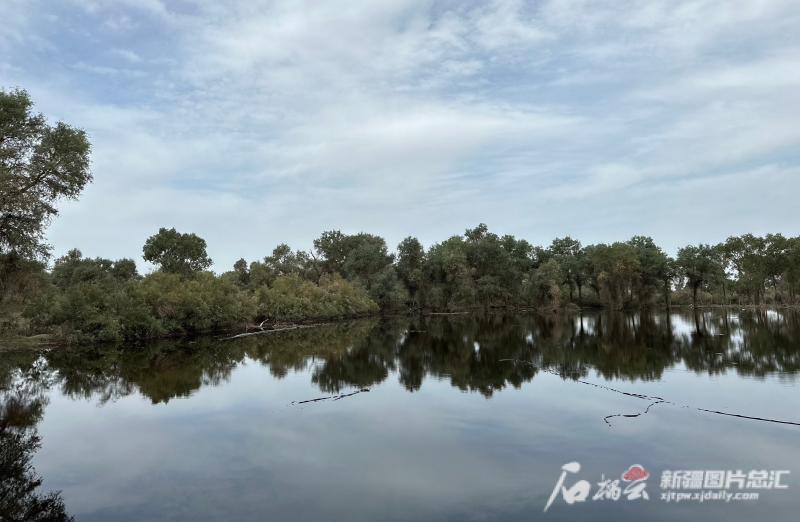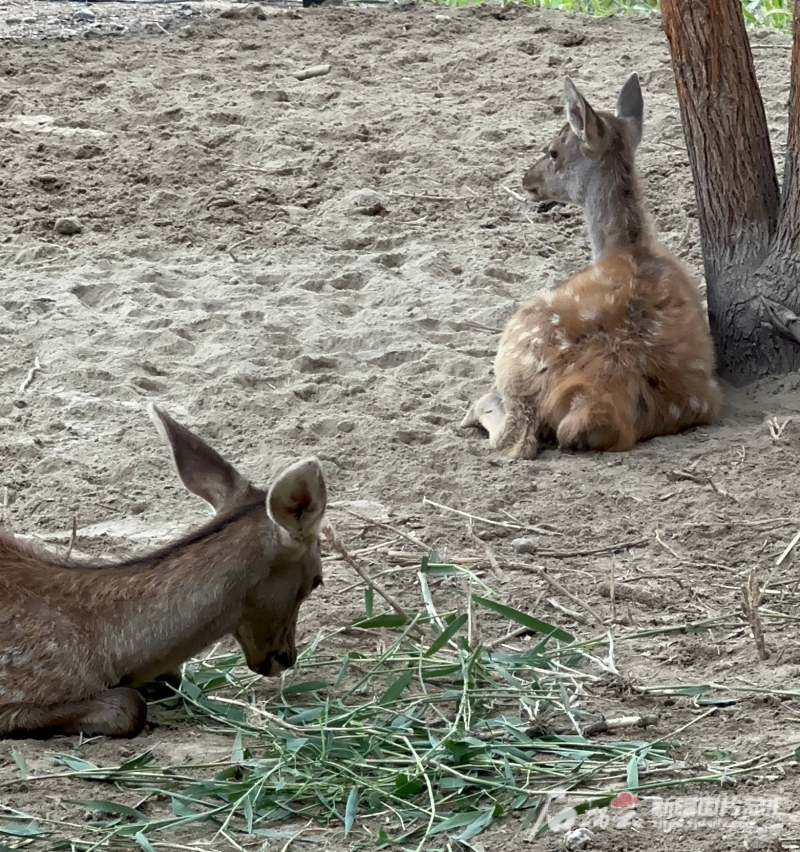Shiliuyun-Xinjiang Daily (Reporter Liu Yiming) news: In the sanctuary's backyard, a handful of crimson deer and a two-month-old golden sheep luxuriate in the warm embrace of sunlight while leisurely grazing. "Observe how they recline and indulge in their meal, but when sheer bliss engulfs them, they spring to their feet with exuberance," remarked Zhai Yuqing, director of the Shaya County Poplar Forest Protection Center's office, his countenance adorned with a smile as he observed the little creature gradually regaining its vitality.
Outside the sanctuary, a majestic row of poplars stands tall, their lush canopies reaching towards the moist water. Following the morning inspection, Aishan Ayiti, director of the Dalang Tangmu Central Management and Protection Institute of the Shaya County Forestry and Grassland Bureau, stood beside the resplendent poplar forest and let out a sigh: "It is truly remarkable how these trees have transformed from near-death five years ago..."
The majestic injured eagle falcon soars back into the heaven, while the resplendent poplar forest rejuvenates with life. Both fauna and flora have been diligently nurtured by the dedicated staff of Shaya County Forestry and Grassland Bureau's Dalang Tangmu Central Management and Protection Institute over the years.
"Previously, I only tended to poplar trees; now my focus has shifted towards the conservation of both poplars and wild animals. Regardless of the fact that the responsibility is demanding, I feel immense joy," Aishan said on September 9th, 2023.
The county of Shaya, situated on the northern fringes of the Tarim Basin in close proximity to the Taklimakan Desert, boasts a majestic crossing of the Tarim River through its county seat. Spanning both banks of this river lie over 4.7 million mu of unspoiled poplar forests. In a region where desert covers eighty percent of its expanse, these poplar forests stand as an indispensable ecological barrier between the arid wasteland and inhabited oases.

Photo taken on September 7, 2023 shows poplar forest in front of the Dalang Tangmu Central Management and Protection Institute of the Shaya County Forestry and Grassland Bureau, northwest China's Xinjiang Uygur Autonomous Region. Photo by Shiliuyun-Xinjiang Daily/Liu Yiming
Aishan and his colleagues are the guardians of this verdant barrier. Having grown up on this land, he possesses a profound affection for poplar trees, particularly as a forest ranger, and comprehends the significance of towering poplars to the villagers.
"People didn't realize that before. When I was a child, as winter approached, the villagers would cut down trees for firewood. At that time, people could not envision the consequences of removing poplar trees from the edge of the desert," Aishan said.
As a result, there were fewer blue skies, and there were many days every year when you look up to see dust. Poplar logging had not been completely stopped until 1999. Later, Shaya Forest Farm was renamed the Shaya County Poplar Forest Management Station and then further renamed as the Shaya County Poplar Forest Protection Center. The change in the unit's name reflects that the protection of poplars became the main goal of the rangers' work from then on.
"Our daily work includes monitoring villagers who cut down trees, preventing forest fires, and most importantly, raising awareness about the importance of poplars," said Aishan.
"If the poplar tree is felled, who will serve as a barrier to prevent sand from encroaching upon the cotton in the field?"
"When you cut down the poplar tree, the grass under the tree is gone. What do your sheep eat when there is no grass? ”
Rangers frequently impart valuable information to the villagers. Moreover, the villagers wholeheartedly embrace these words, and most importantly, the enhancement of the ecological environment has also yielded benefits for their production and livelihoods. In 2016, Shaya County initiated the Tarim River Basin Poplar Forest Ecological Protection Action, organizing and implementing a remarkable 8 million cubic meters of ecological water replenishment in the Poplar Forest Reserve of the Tarim River Basin, impacting an expansive area of 96.230 million mu with a primary focus on fortifying the ecological and natural resilience of poplar forests in this region.
Subsequently, the water level of the Tarim River increased significantly, and the area that could be moisturized by the river during the flood season expanded. The grassland also experienced growth. Every year during the flood season, Shaya County Poplar Forest Protection Center carries out flood diversion and irrigation activities to improve the ecological environment of the Shaya section of the Tarim River. Measures such as ecological water transmission, flood diversion and sealing, conversion of farmland to wetland, replanting poplar forests, and pest control have greatly contributed to restoring over 1.8 million mu of poplar forest ecological area.
"Many poplar trees, which were on the verge of dying, have sprouted new shoots due to the water. Previously devoid of leaves due to pests and diseases, now you can see that poplar trees are flourishing," Aishan happily briefed reporters on the changes that had taken place here.
What brings Aishan even greater joy is the remarkable improvement in the ecological landscape, characterized by an abundance of pristine water and lush grasslands. Furthermore, the restoration efforts have successfully revived populations of wild creatures such as red deer and yellow sheep.
"In the past, red deer were rarely seen during patrols, but in recent years, we have added an additional step to our work of rescuing wild animals that have been injured in the wilderness." Aishan mentioned that the workload is heavy, but everyone is very happy.

Photo taken on September 7, 2023 shows a previously injured wild red deer grazes at the Dalang Tangmu Central Management and Protection Institute of the Shaya County Forestry and Grassland Bureau in northwest China's Xinjiang Uygur Autonomous Region. Photo by Shiliuyun-Xinjiang Daily/Liu Yiming
"In the backyard of the Dalang Tangmu Central Management and Protection Institute, the house originally constructed for untamed creatures has gradually expanded in response to an augmented animal population. "It has undergone a splendid recovery and is now poised to take flight," exclaimed Aishan as he observed the majestic eagle on his arm ascend into the azure sky following a gratifying repast.
"We attend to nearly 30 wild animals annually, and the conscientiousness towards safeguarding both poplars and wildlife has permeated not only the rangers but also the neighboring herders. Should they chance upon injured creatures during their grazing endeavors, they promptly send them to our care." Zhai Yuqing revealed that apart from red deer, their sanctuary has successfully rescued Mongolian gazelle, eagle falcons, as well as elegant white swans migrating all the way from Siberia. In order to enhance animal rescue efforts, a team of dedicated wildlife rescuers is stationed at the sanctuary while all other staff members are required to possess fundamental knowledge in this domain.
"I find my work meaningful and enjoyable. During the autumn season, when the poplar forest turns golden, it becomes a popular attraction for tourists. Despite being busier during those times, we never neglect our responsibilities of caring for the poplar trees and wildlife," Aishan explained.
(A written permission shall be obtained for reprinting, excerpting, copying and mirroring of the contents published on this website. Unauthorized aforementioned act shall be deemed an infringement, of which the actor shall be held accountable under the law.)









